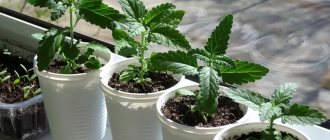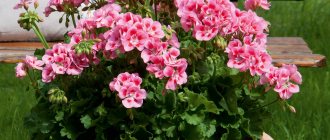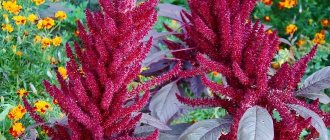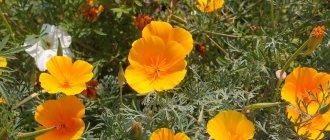Large-flowered purslane appears more and more often on the balcony, grows well in pots and in the garden. Its large, very bright flowers attract attention and catch the eye. The garden species can be eaten. From this article you can find out what kind of purslane plant is - planting and care, photos of interesting varieties, features of growing from seeds, when to plant and what this unique flower needs.
Description and types of purslane, popular varieties
Purslane is a succulent plant, a herbaceous annual. It is widespread in the southern regions, where there is a warm climate. The plant forms a branched bush with a recumbent smooth stem of a reddish hue, up to 30 cm long. Leaves without cuttings, fleshy, ovate, look like spatulas.
The flowers of garden purslane are small (2-3 cm in diameter), simple, yellow in color. Decorative varieties have large flowers (up to 10 cm in diameter), bright, cup-shaped. The color of the petals can be white, red, pink, peach, orange. The buds bloom in June, flowering lasts until the end of summer. The seeds are collected in the fruit - a spherical box.
Purslane grandiflora is an attractive ornamental plant that decorates the flower garden until the first frost.
Purslane is divided into several types:
- Ampelous is a perennial hybrid species that is grown in open ground. The flowers are simple and come in various shades of red, white, purple and yellow. Flower growers plant ampelous purslane in hanging baskets and tall flowerpots so that the shoots hang beautifully.
- Garden purslane is an edible plant. It has beneficial and medicinal properties. The flowers of the plant are yellow and small in shape. The leaves are oval shaped and succulent.
Young leaves of garden purslane are used as food. They are put in salads, stews, seasonings, and pickled for the winter. In folk medicine, the plant is used externally as a wound-healing and anti-inflammatory agent. A decoction of seeds or leaves is taken internally to lower blood sugar levels, increase blood pressure and increase heart rate.
Purslane - food, healer, hormone of happiness and joy: video
- Large-flowered is a very popular species with a variety of flower colors. They decorate garden beds and are used to decorate summer cottages. In Russia, large-flowered purslane is grown as an annual plant.
- Terry is a variety of large-flowered purslane. The plant is low-growing with double flowers. Its most popular varieties are Splendence and White-flowered.
Popular varieties
Variety Splendex
- Red or scarlet purslane is one of the shortest among the representatives of the genus. The height of the branched bush is 12 cm. It is covered with small leaves and bright scarlet flowers, up to 5 cm in diameter. Flowering lasts until the first cold weather. The buds open only on a clear, sunny day.
- White purslane is attractive with large double flowers. The petals in the bud are snow-white, the core of the flower is bright yellow. The variety is characterized by rapid growth, reaching a diameter of 40 cm. The plant is resistant to heat and can grow on poor, rocky soil.
- Pun . A variety that includes plants with flowers of different colors and shapes (simple and double). The bush is creeping and can be planted as a ground cover.
- Sanglo. Purslane variety, with flowers up to 6 cm in diameter. They are densely terry, open even in cloudy weather. Colors: white, pink, yellow, red, salmon.
- The Splendex variety is characterized by purple-pink flowers, up to 4 cm in diameter. The height of the bushes is 10-12 cm.
- Flamenco. Purslane, 20 cm high and flowers of white, yellow, scarlet, pink color. The plant does not tolerate clay and damp soils and withstands drought well.
Variety Flamenco
The common feature for most varieties of purslane is prolonged flowering, until the arrival of frost, which will kill the plant. If you plant bushes in containers, you can prolong the bright flowering by placing the purslane in a warm place in the fall and providing lighting.
General information about the plant
This plant has been known for a very long time. Already in the Middle Ages, it was grown as a vegetable crop and used as a medicinal plant. The popular name for purslane is rug. This is due to the fact that the plant spreads over the surface of the earth, like a carpet.
Many gardeners are familiar with the wild brother of this flower crop - purslane . The attitude towards him is not the most enviable - like a weed.
But it can also bloom, but the yellow flowers are very small. By the way, it is believed that garden purslane can be eaten. In addition, it contains nutrients and vitamins and is used for medicinal purposes.
The most popular decorative species is Purslane grandiflora. This is what gardeners grow on their plots as a decorative flower. Also popular is Terry purslane , it is a variety of large-flowered. Growing a flower from seeds at home is possible for both the first and second types.
In the photo on the left is a large-flowered purslane, and on the right is a double-flowered one:
The flower has branched, creeping stems, juicy fleshy leaves, which also surprise with their beauty, just like the flowers. The maximum height of the plant is about 20 centimeters. And the diameter of the flowers is about 3 centimeters. Flowering - from June to September.
Note! Decorative purslane is a perennial plant, but in Russia it is most often grown as an annual.
The flower mat looks perfect on alpine slides and is very successfully used as a decoration for borders. The creeping plant can be grown in flower beds in open ground, in flowerpots, vases, in balcony and window boxes. All of the options listed are interesting and beautiful.
By the way! If you like non-standard and original garden solutions, you can take advantage of the experience of some gardeners: growing decorative purslane between garden slabs that form paths in the garden.
Typically, seeds are sold that grow into colorful plants, so you can plant flowers that come in a variety of pleasing shades—red, yellow, pink, etc.
When to sow purslane for seedlings
To admire purslane flowers already in June, you need to start sowing seeds already in March - April. The exact sowing time depends on the climate of the region where the site is located. Purslane does not tolerate sub-zero temperatures; seedlings are planted when warm weather sets in. The optimal age of purslane seedlings ready for planting in a flowerbed is about 8 weeks.
Based on these data, approximate dates for sowing purslane are obtained, depending on the region of residence:
- in the middle zone and Moscow region, seeds are sown from March 15 to April 10;
- in the Urals and Siberia in April;
- in the southern regions you can start sowing at the end of February - early March.
Keeping a weather calendar will help determine the optimal sowing time in a particular area. Records about the date of the last spring frost, the average daily temperature, made over several years, will help you choose the right time for planting.
Many gardeners and flower growers use tips from the Lunar calendar. It is believed that depending on the phase of the moon, certain parts of the plant (aerial or roots) grow intensively. There are favorable dates for sowing various crops and days prohibited for agricultural work. For example, on the days of the Full Moon and New Moon you cannot plant or prune plants.
How is garden purslane useful?
Benefits of purslane:
- Strengthens the immune system, as it contains many vitamins.
- Saves from insomnia.
- Reduces cholesterol levels.
- Has a beneficial effect on the functioning of the heart.
- Normalizes the functioning of the gastrointestinal tract.
Growing purslane is a simple process that takes a minimum of effort and time, but its growth must be controlled. Otherwise, after some time you will have to fight the plant, like other weeds.
The crop is propagated by seeds and division. You can grow it in seedlings, or sow the seeds directly into the soil.
How to grow purslane from seeds at home
Growing purslane from seeds is no more difficult than any other annual. The gardener needs to acquire soil, seedling containers, seeds and lamps for illumination if the seedlings are prepared before April.
Soil selection
Loose, light and infertile soil with a significant admixture of sand is suitable for the crop. At a flower shop you can purchase a ready-made substrate for succulents or “Universal” seedling soil. Purslane can be sown in the soil for cacti immediately, and the “universal” soil can be diluted with vermiculite or coarse sand, adding it in an amount of 25-30% of the total soil mass.
You can prepare soil for the plant yourself, using a mixture of peat, sand (vermiculite) and turf soil. All components are taken in equal shares. Humus and fertilizers are not added to the soil. It will be useful to add pieces of charcoal to the finished soil in a proportion of 20% of the total volume of the substrate.
Attention! Purslane is sensitive to fungal infections. To protect the plant from infection, the seedling soil must be disinfected: watered with a solution of potassium permanganate or Fitosporin.
Seed preparation
Purslane seeds are very small, comparable in size to petunia or poppy seeds. When properly stored (cool and dry), they remain viable for up to 3 years. When buying seeds in a store, you need to pay attention to the expiration date of the seeds and take the freshest ones.
To increase the germination percentage, some gardeners soak the seeds in the growth stimulator Epin or Zircon. In order not to lose the tiny seeds, they are immersed in the drug solution, scattered between two cotton pads, and tied with a thread.
Instead of ready-made drugs, you can use a natural stimulant - aloe juice. A few drops of juice, squeezed from a leaf that has been in the refrigerator for about 10 days, are dissolved in a glass of warm water.
Sowing methods
Purslane is sown in wide and shallow bowls (5-6 cm high). You can sow directly into separate cups, choosing wide and not tall ones, or into peat pots. It is convenient to sow flowers in seedling cassettes, where the plants develop in individual cells.
The container in which the seedlings will be located must have drainage holes. Stagnation of moisture in the soil has a detrimental effect on the root system of the succulent. In order to arrange additional drainage, it is useful to pour a little fine gravel or expanded clay onto the bottom of the container.
Landing step by step.
- Seedling containers filled with soil are well moistened.
- Seeds are scattered onto the damp surface of the soil, being careful not to sprinkle them too thickly.
Important! Due to their small size, the seeds cannot be covered with soil!
- The bowls with the crops are covered with a piece of glass or plastic wrap. Place the boxes in a warm place (temperature at least +25 degrees). In order for purslane seedlings to be friendly, the seeds must be exposed to sunlight. Until the sprouts appear, it is necessary to open the containers every day and ventilate the plantings. If necessary, moisten the top layer of soil with a spray bottle.
Some experienced flower growers practice sowing small seeds in the snow. A layer of snow 1 cm thick is placed on the surface of the soil and seeds are scattered on it.
This technique solves two problems at once: the density of seed distribution is clearly visible on a white background, and melt water has a beneficial effect on germination activity. There is no need to be afraid that the seeds will freeze; the snow layer will melt in the warmth in a couple of hours and will not cause harm to the plant.
We sow terry purslane. Sowing large-flowered purslane for seedlings - video
Seedling care
The first purslane sprouts may appear on the surface within three days after sowing, the rest will appear within a week. As soon as the sprouts appear on the surface, the film or glass is removed, providing the seedlings with maximum light.
Purslane seedlings are kept on the brightest windowsill - south or southeast. It is useful to supplement the plants with fluorescent lamps or special phyto lamps, extending daylight hours to 10-12 hours. Lack of lighting leads to stretching of bushes and loss of decorativeness.
Comfortable temperature in the room where purslane grows is +18 +20 degrees.
Watering the seedlings is carried out using a syringe or syringe, moistening the soil moderately. When the purslane grows, it is convenient to water the seedlings through a tray. The exception is plants planted in peat pots. They can only be watered from above, otherwise the bottom and walls of the pot will get wet and tear.
Important! You can’t overwater purslane! The next moistening is carried out when the top layer of soil dries out.
For irrigation, use only soft, settled water at room temperature. You can use melt or rain moisture.
Purslane does not require fertilizing. To prevent the development of the “black leg” disease, the seedlings are watered a couple of times with a solution of Fitosporin M.
If the seedlings are sown densely and begin to stretch out, they need to be replanted. The procedure is carried out in the phase of appearance of 2-3 true leaves. Replant small plants carefully, using a toothpick, trying not to damage the roots. After picking, it is useful to water the purslane with a solution of root or Heteroauxin.
Features of collecting purslane seeds
The flowering of terry purslane is very abundant. The splendor and splendor of the petals and leaves does not allow us to notice one feature - the short life of each bud. They do not live more than one day, quickly withering away. After this, the fruits are set and small boxes are formed that contain the seeds. It is from these boxes that the contents should be obtained, preventing them from getting into the ground, that is, preventing self-seeding.
If you refuse to collect purslane seeds, they will end up in the ground. In the next summer season, new plants will appear, which will bloom only at the end of summer.
Features of collecting purslane seeds are as follows:
- Throughout the entire growth period, you will periodically need to feed the plant with mullein. This is done three times, every 14 days.
- After feeding, the plant’s seed pods form and open. The flower stems will begin to turn slightly yellow.
- When observing the processes described above, you should dig up the purslane with its roots, and then shake off the soil. The leaves should not be trimmed.
- The excavated elements are placed in a well-ventilated area. It is advisable to hang it on well-tensioned ropes. Place a cloth (preferably burlap) under the hanging plants.
- As the suspended purslane dries, it will open pods from which the seeds will fall.
- Collect the seeds and store them until spring.
The duration of storage of purslane seeds should not exceed five years. After this period, the germination percentage will almost completely decrease.
When and how to transplant purslane seedlings into open ground
The seedlings are moved to the flower garden when the threat of frost has passed and the weather has settled with a night temperature of at least +10 degrees. In the middle zone, suitable weather occurs in mid-to-late May. In regions with cold climates, purslane is planted in beds in June.
If the flower has already been planted, but cold weather is expected, small bushes are covered with cut plastic bottles or arches are installed and covering material is pulled on.
For purslane, choose well-lit areas. Only in bright sun will flowering be abundant and bright. It is ideal if the flowerbed is protected from the cold wind by buildings or plants.
The soil in the garden bed must be breathable, neutral or alkaline. To loosen it, add sand, fine gravel, and granite chips.
Attention! Do not add humus or compost to the ground. Excess fertilizer leads to active growth of greenery, but flowering will be poor.
Before planting purslane in the garden, the seedlings must be hardened off - accustomed to fresh air. To do this, 10-12 days before planting in the ground, the plants are taken outside “for a walk.” At first, the duration of sunbathing is an hour to an hour and a half, gradually increasing the time spent outside.
Planting purslane in open ground
- Purslane is planted at a distance of 10-20 cm from each other, compact varieties are placed closer to each other.
- The plant is transferred from the seedling container to the hole without collapsing the earthen ball. The bush is not buried; it is planted as it grew in the pot.
- After planting, purslane is watered abundantly.
The procedure for planting seedlings in open ground is best done in the evening or in cloudy weather. To facilitate the adaptation of plants in a new place, water them with Heteroauxin or spray the foliage with Epin.
Purslane – photo
At first glance, purslane may seem too simple and inconspicuous. But to be convinced of the opposite, it is enough to see what a luxurious “carpet” it turns into. To do this, we offer you a whole selection of photos!
Photo: semena-zakaz.ru
Photo: oz90.ru
Photo: sadagro.ru Photo: botanichka.ru Photo: water-vao.ru
Photo: sady-msk.ru
Photo: 2sotki.ru
Photo: nagrunte.ru
Photo: 2sotki.ru
Photo: keywordbasket.com
Photo: plantarium.ru
Photo: pixelrz.com
Photo: fedsp.com
Photo: happyho.ru
Photo: dachamir.ru
Photo: hostingkartinok.com
Photo: demiart.ru
Photo: 2sotki.ru
Photo: sad4you.ru
Photo: tricornmedals.com
Photo: 2sotki.ru
Photo: soloserv.ru
Did you like the post? Subscribe to our channel in Yandex.Zen, it really helps us in our development!
Further care for purslane
The flower can rightfully be called an unpretentious plant. All he needs is light and warmth. Purslane tolerates drought well, but it needs moisture for lush flowering.
Watering
For purslane, it is enough to moisten the soil once a week. If there is precipitation, watering is postponed until the top layer of soil dries. Water at the root, without getting water on the flowers.
Use only warm water, preferably soft (rain, from a river, pond).
Weeding, loosening
While the purslane bushes are small, the flower garden is regularly weeded, and the soil is loosened after watering. Later, the plants grow and the bushes close together. The need for earthworks disappears.
If rainy weather sets in, it is necessary to loosen the soil around the bushes more often, drying it out. It is useful to arrange grooves around the flower bed to drain excess moisture.
Fertilizers for abundant flowering
Purslane is not fed with anything, since excess nutrients lead to green growth, to the detriment of flowering. To form large bright buds, purslane needs sun and warmth.
Soil and seed container
Let's find out what kind of soil you need to plant purslane seeds in, and what container you will need for this.
Priming
For successful germination of purslane seeds, a light, breathable substrate is well suited. You can use ordinary garden soil mixed with ground charcoal. It is better not to use store-bought ready-made substrate, as it contains a lot of peat.
If the soil contains a lot of clay, mix it with coarse sand in a ratio of 60:40. Be sure to bake the components of the soil mixture in the oven or otherwise disinfect them.
Important: the soil should not contain a lot of nutrients: oddly enough, purslane grows and blooms better in poor soil.
Capacity
The container for seeds needs to be low, but quite wide. The height of the container walls should not exceed 10 cm. Otherwise, seed germination will be lower, and the seedlings themselves will develop worse at an early stage.
Plastic containers are suitable, including those for salads, cakes, and other ready-made dishes. Be sure to make holes in the container to drain excess liquid. It is recommended to lay a thin drainage layer of small expanded clay pebbles at the bottom.
When and how to collect seeds
Purslane seeds have time to fully ripen in the short summer of the middle zone, and they can be used for further sowing. The seeds ripen in a seed pod, which is called a “little box” because of its resemblance to the vessel of the same name.
A signal of seed ripeness is the coloring of the seed pods brown or brown. They are collected from the plant and dried at home. The seeds are removed by breaking the capsules and pouring the seeds onto paper. Store purslane planting material in a dark, dry place, in a glass jar or paper bag.
Diseases and pests
Large-flowered and double purslane are resistant to many diseases and pests. However, the following problems may occur:
- Spots on the leaves or deformation of the shoots indicate a fungal disease. The plant must be treated with preparations containing copper, for example, copper sulfate.
- Sometimes the plant is attacked by aphids. It can be combated with an insecticide solution, for example, Agravertine, Ankara.
- The flower can be affected by thrips - it appears in the form of specks or silvery stripes. Plants are treated with the same preparations as for aphids.
Important! To prevent the plant from being affected by pests and diseases, do not over-moisten the soil.
Growing purslane from seeds at home is not difficult, the main thing is to follow the recommendations described in this article, and you will be able to enjoy the beautiful flowering of this plant for a long time.
Watch the video! Purslane flowers - growing and care
Purslane in landscape design
Purslane, due to its compact size and drought resistance, is an ideal container plant. It is actively planted in balcony pots and flowerpots.
The plant looks appropriate in a rocky garden and on an alpine hill, in the foreground of mixed flower beds. Purslane is often planted to replace fading bulbous flowers.
What flowers are combined with in the flowerbed?
The low-growing bright purslane is beautiful in a monoflower. It is self-sufficient and does not require additions. It can be combined:
- with silvery cineraria;
- bright celosia;
- alyssum;
- petunia;
- dwarf roses;
- pansies;
- marigolds.
Where to buy seeds?
You can purchase purslane seeds in specialized flower shops, or order them by mail and through online stores.
| Variety | Where can I buy | Price |
| Arctic | Agrosemfond LLC (Nizhny Novgorod, delivery throughout Russia) | 25 rubles |
| Pink haze | Online store “Seeds Here” (Delivery throughout Russia) | 23 rubles |
| Sandalwood Golden | Semenapost.ru (Delivery throughout Russia) | 39 rubles |
| Happy Travels yellow | Seedspost.ru (Delivery throughout Russia) | 68 rubles |
7. Reproduction
There are 2 ways to propagate purslane - seed and growing from cuttings. Using seeds, it is easy to obtain a large number of plants in a short period of time. The disadvantages of this method include the fact that some varieties of large-flowered purslane do not retain varietal characteristics. Cuttings allow you to obtain plants with wilted characteristics.
↑ Up,
7.1.Growing from seeds
Purslane propagates by seeds, very easily. To sow a flower, you can use your own collected seeds, but for this you need to prepare and store them correctly. Interestingly, freshly harvested seeds have a very low germination rate - it increases only after the planting material is six months old.
In general, the formation and ripening of purslane seedlings occurs quite quickly - within only 2 weeks after pollination of the flower. If the air temperature stays within 15 - 17 degrees, then seed ripening can take up to 1 month.
↑ Up,
To prevent the seeds from spilling onto the ground on their own, the still green seed pods are wrapped in a bandage or gauze. The ripened brown boxes are separated from the plants - the seeds are poured onto a sheet of paper and left to dry in a warm and ventilated room.
Planting material is stored in paper envelopes in a cool and dry place and if these simple rules are followed, the seeds remain viable for 3 years.
↑ Up,
7.1.1.How and when to sow
Seeds are sown in spring - in open ground or in early March in pots and containers at home. Purslane often forms self-sowing - when growing in the garden, you should be careful with garden purslane. The fact is that these plants very quickly form seeds, which are immediately sown in the ground. Getting rid of such a bush will not be easy.
For sowing, prepare seedling boxes with drainage holes and a transparent plastic lid. Fine expanded clay is placed at the bottom of the boxes or foam balls are poured - these materials will serve as a drainage layer. fill the container with a substrate with a reduced peat content. The surface of the earth is leveled and thoroughly moistened with water from a spray bottle.
↑ Up,
Since the seeds are very small, they are simply slightly pressed into the surface of the earth or covered with a very thin layer of soil. To ensure uniform sowing, the seeds are picked up with the tip of a damp toothpick or wooden skewer. You can also pre-mix the seeds with a small amount of river sand.
After sowing, the plants are covered with a cap or glass to create a greenhouse effect. Seedlings are left in a room with good indirect lighting and an air temperature of about 23 - 25 degrees Celsius. In general, higher temperatures will promote more complete and rapid germination of planting material.
The seedling boxes can even be left on the radiator until the first shoots appear. Every day the shelter is removed, ventilated and water condensation is removed from the bottom of the hood. The soil is kept evenly moist by spraying the soil with a spray bottle. If you follow this agricultural technology, the first shoots can be noticed within 1 - 2 weeks - with their appearance, the cover is completely removed.
.
↑ Up,
7.1.2.Caring for seedlings
Since insufficient lighting the bushes stretch out and become weak, it is worth organizing additional lighting using LED or fluorescent lamps. turn on artificial lighting in the morning and evening hours, increasing the duration of daylight hours to 12 - 14 hours. At night the lights must be turned off.
When the seedlings develop 2 to 4 true leaves, the bushes are planted in their own separate small cups with drainage holes. When diving, it is worth using the same soil composition in which the seeds were sown. It is permissible to place 2 - 3 plants in each cup.
Diving is carried out using the transshipment method, carrying the bushes along with an earthen lump on the roots. If the bushes are stretched out due to lack of light, you can deepen them a little when diving.
The seedlings are left in a brightly lit place without direct sun access, and evenly watered with warm water. 7 - 10 days after the dive, you can carry out the first fertilizing with nitrogen fertilizers in a very weak concentration.
↑ Up,
7.2.Cuttings
With the help of stem cuttings, it is possible to preserve double, beautifully flowering specimens. Cuttings are carried out in late spring or early summer. Stem cuttings from the top of the shoots are cut with a sharp sterile pruner or knife. The lower leaves are removed from the cuttings and the bases of the shoots are dipped in powder for rooting.
Prepare small cups with drainage holes and well-moistened soil, half consisting of river sand. The cut site is dried in the open air for several hours and the base of the cuttings is immersed in the soil to a depth of about 1 cm at a slight angle.
The plants are covered with a plastic bag to reduce moisture loss and left in a warm and well-lit place without direct sun. The fact that the first roots have appeared underground can be judged by new, young leaves and shoots - rooting was successful.
Roots also form well in barely damp river sand or even in a simple glass of water. Add an activated carbon tablet to the rooting water and change it every 5 days.
↑ Up,
Watering and fertilizing
Annual sprout
It is not recommended to water the flower abundantly and often: it is enough to do this once every 4-5 days. It is best to use settled or melt water for moisturizing. Hard water significantly reduces the percentage of seed germination and the abundance of flowering.
Watering is carried out using a watering can under the root or from above. The succulent easily tolerates prolonged drought and requires more moisture than usual only on hot days.
Excessive moisture along with low air temperature can lead to the appearance of fungal diseases of the plant. If the plant still does not have enough watering, it will react to the lack of water by dropping leaves and exposing the stems.
The soil under the seedlings must be regularly loosened and cleared of weeds until the plant grows and covers the soil with leaves. After this, the flower does not need loosening, weeding or mulching.
additional feeding is required for the unpretentious succulent. If the gardener wishes, you can fertilize the soil with a liquid solution of cow manure or other organic matter, but not more than once per season.
4. Medicinal properties of the flower and contraindications
The healing properties of purslane became known to ancient Roman and Greek doctors - the plant was used in medicine by Galen and Hippocrates. The flower was mentioned by Pliny and Theophrastus in their works. At that time, the flower was often used after snake bites - it was believed that it could resist snake venom.
In Egypt, asthenia was consumed as food. The green mass of plants was crushed and taken orally for diseases of the bladder and digestive organs. By applying the paste to the skin, people believed that it would help get rid of defects such as warts and pimples and relieve swelling from the eyes.
↑ Up,
In Arab countries, medicinal properties were widely used for disorders of the kidneys and liver. Also, as now, dandur was taken in the initial stages of diabetes.
Currently, the medicinal properties of the flower are also recognized and it is often used in medicines used in the treatment of various parasites. In folk medicine, the plant is used to strengthen the heart and increase blood pressure. The juice of the leaves is believed to have wound healing properties.
Contraindications to the use of purslane are high blood pressure, heart disease, increased nervousness and excitability. Do not give the herb to children and use it during pregnancy and breastfeeding.
↑ Up,
4.1.Procurement of raw materials
In order for plants to retain the maximum amount of useful substances, they must be properly collected and stored. To harvest leaves and then use them as medicinal raw materials, it is worth choosing the moment when the first buds appear on the vegetable purslane bushes.
The entire above-ground part is cut off and placed in a warm, ventilated place to dry for several days. After drying, the leaf blades are separated, collected into fabric bags or paper bags and stored in a dry and cool place. Such raw materials can be used within 1 - 2 years after collection.
↑ Up,
Only young shoots and tender upper leaves, which are cut off before the flowers form, are suitable for culinary use. This cutting can be done several times a season - the tops grow back each time. Pruning is carried out with a sterile instrument, leaving only 3 - 4 cm of growth above the ground surface. Sufficiently young plants with a height of 15–20 cm are suitable for cutting.
↑ Up,











